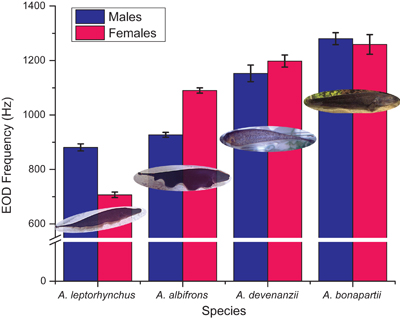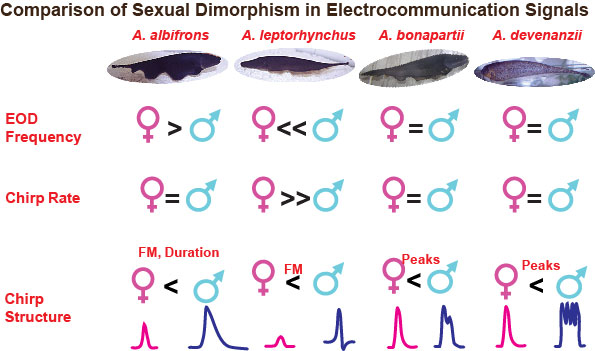Evolution of sex differences in electrocommunication signals
Different species of electric fish vary in the degree of sexually dimorphism of their electrocommunication signals. For example, EOD frequency is sexually dimorphic in both brown ghost and black ghost knifefish (A. leptorhynchus and A. albifrons), but the sex difference is in opposite directions in the two species (Dunlap et al. 1998; Kolodziejski, Nelson, and Smith 2005). In A. leptorhynchus, male EODs are higher in frequency than those of females, whereas in at least some populations of A. albifrons, males EODs are lower in frequency than those of females. Other apteronotid species, including marble-leaf knifefish (Adontosternarchus devenanzii) and dragon knifefish (Apteronotus bonapartii) produce EODs that do not differ between the sexes (Zhou and Smith 2006; Ho, et al. 2010). Examples like this, in which both the magnitude and the direction of sex differences in behavior vary across closely-related species, are relatively rare and provide an opportunity to study how sex differences evolve. We are also studying variation in the sexual dimorphism of EODs across different populations of the same species.
 |
Variation among species in the sexual dimorphism of EOD frequency (EODf). EODf (mean±SEM) of males and females of four different apteronotid species studied in the Smith lab. The direction of the sex difference in EODf is reversed between A. leptorhynchus and A. albifrons. EODf is sexually monomorphic in A. devenanzii and A. bonapartii. |
Sex differences in chirping also vary across species. In A. leptorhynchus, chirping is highly sexually dimorphic. Males chirp much more than females, and males also produce high-frequency chirps that are almost never produced by females. Although chirping is also sexually dimorphic in other species that we have studied (A. albifrons, A.devenanzii, and A. bonapartii), sex differences in the chirps of these species are more subtle (Kolodziejski, Nelson, and Smith 2005; Zhou and Smith 2006; Ho et al. 2010). Unlike in A. leptorhynchus, there is no significant sex difference in the number of chirps produced in these species. Instead, males and females differ mainly in the structure of their chirps. Male A. albifrons are somewhat more likely to produce high-frequency chirps than females, and their chirps are longer in duration than those of females. In A. devenanzii and A. bonapartii, males are more likely than females to produce "multi-peaked chirps". Thus different species differ both in sex differences in the amount of chirping and in what aspects of chirp structure are sexually dimorphic. A current focus of our research is to characterize sex differences in EOD frequency and chirping across many different apteronotid species to understand how sex differences in electrocommunication behavior evolved.

